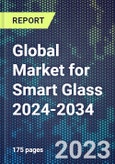Smart glass refers to specialty glass or glazing solutions that can dynamically modulate light transmission or opaqueness in response to voltage, light, or temperature inputs. This switchable functionality enables user-controlled dimming, privacy, heat management, and energy savings across diverse industries. The use of smart glass is an effective way of minimizing energy consumption in buildings. The unique light and heat-adaptive nature of smart glass is made possible by advanced underlying technologies that induce reversible changes in specialized glass materials through applied stimuli.
The Global Market for Smart Glass 2018-2034 provides a detailed analysis of this market, covering key smart glass technologies including electrochromic, thermochromic, and PDLC switchable glass. End users markets such as construction, automotive, and aerospace are extensively covered. Regional demand analysis and growth projections are provided for markets including North America, Europe, Asia Pacific, and the Rest of the World.
Profiles for over 50 major companies working on smart glass and related technologies are included. The report focuses on key details around market size, segmentation, growth factors, challenges, emerging applications, product innovations, and future roadmap. It aims to quantify the opportunity presented by smart glass, windows, and dynamic glazing solutions. With sustainability concerns around energy conservation and green buildings taking centre stage, this research analysis helps identify specific areas of product enhancement and regional trends reshaping demand. Companies can leverage the granular demand forecasts to 2034 by technology and geography to focus innovation pipelines, localization strategies and predictive capacity planning as next-generation dynamic glass gets embedded across industries.
Report contents include:
- Global smart glass market revenue forecasts segmented by technology, end-use industry, region through 2034.
- Analysis of market drivers like energy regulations, EVs, reducing energy use, mega-trends.
- Overview of smart glass technologies - electrochromic, thermochromic, SPD, PDLC, etc.
- Discussion of applications across architecture, automotive, aerospace, and consumer devices.
- Commercial application analysis - buildings, healthcare, transportation etc.
- Comparative assessment of smart glass materials.
- Company profiles for 50 manufacturers and start-ups. Companies profiled include AGC Inc., Andluca Technologies, ChromoGenics AB, ClearVue Technologies, Gauzy Ltd, Halio, Inc., HIVISQ, Saint Gobain, SageGlass, UbiQD and View, Inc.
- Review of new products, partnerships, investments and funding trends.
- Breakdown of demand growth projections for North America, Europe, Asia Pacific, China.
- Challenges analysis covering costs, switching speeds, fabrication limits etc.
- Emerging materials outlook.
- Sustainability impact - recyclable panels, photocatalytic coatings, energy saving potential.
- Future outlook addressing required innovation areas, new capabilities, roadmaps.
This product will be delivered within 1-3 business days.
Table of Contents
Companies Mentioned (Partial List)
A selection of companies mentioned in this report includes, but is not limited to:
- AGC Inc.
- Andluca Technologies
- ChromoGenics AB
- ClearVue Technologies
- Gauzy Ltd
- Halio Inc.
- HIVISQ
- SageGlass
- Saint Gobain
- UbiQD
- View Inc.
Methodology

LOADING...








